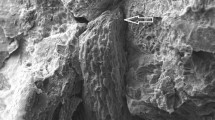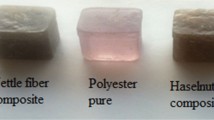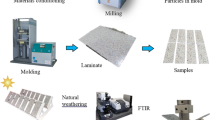Abstract
The effect of the amount of desorbed water on the mechanical properties of composites based on low-density polyethylene and linen yarn production waste (LW) is analyzed by statistical methods. It is shown that the amount of absorbed water decreases during the desorption process at room temperature both for specimens modified and unmodified with diphenylmethane diisocyanate (DIC.) The most sensitive to the action of water is the elastic modulus, which decreases considerably under the effect of water and is fully restored in the desorption process. The tensile strain also increases with the amount of absorbed water. It is found that the elastic modulus of the unmodified composite correlates linearly with the amount of desorbed water. Between the amount of desorbed water and the tensile strain, as well the specific work of deformation, a negative linear correlation is revealed. After water desorption, all strength and deformation characteristics of both the modified and unmodified composites are fully recovered.
Similar content being viewed by others
REFERENCES
A. R. Sanadi, D. F. Caulfield, and R. E. Jacobson, Paper and Composites from Agro-Based Resources. Chap. 12. Agro-Fiber Thermoplastic Composites, Boca Raton-CRC Press-Lewis Publishers (1997), pp. 377–401.
R. M. Taib, H. D. Rozman, Z. A. Mohd Ishak, and W. G. Glasser, “Development of high-performance polypropylene composites using steam-exploded Acacia Mangium fibres,” in: Proc. 4th Int. Wood and Natural Fibre Composites Symp., April 10–11, Kassel, Germany (2002), pp. 4–1/4-14.
Ton Peijs, “Composites turn green!,” e-Polymers, Sci. e-Only Polym. J., T-002 (2002).
I. Bendzala and B. V. Kokta, “The properties of LDPE filled with fast-growing grass,” in: Proc. 3rd Int. Symp. Materials Made from Renewable Natural Resourses, September 5–6, Erfurt, Germany (2001), p. 136.
J. X. Reitveld and M. I. Simson, “The influence of absorbed moisture on the processability and properties of a wood flour-filled polypropylene,” in: M. P. Wolcott (ed.), Wood Fiber Composites, Fundamental Concepts, Processes and Material Option, Forest Products Soc. (1993), pp. 39–46.
J. Kajaks and S. Reihmane, “Thermal and water sorption properties of polyethylene and linen yarn production waste composites,” Angew. Makromol. Chem., Bd4755, No.272, 24–26 (1999).
J. A. Kajaks, S. A. Reihmane, V. N. Bulmanis, and J. E. Lejnieks, “Effect of water on the physicomechanical properties of composites containing low-density polyethylene and linen yarn production waste,” Mech. Compos. Mater., 37, No.2, 167–170 (2001).
J. E. Lejnieks, J. A. Kajaks, and S. A. Reihmane, “Analysis of tensile strength-deformation parameters by mathematical statistics methods,” Mater. Sci. Appl. Chem., 4, 110–123 (2002).
J. E. Lejnieks, J. A. Kajaks, and S. A. Reihmane, “Evaluation of deformation and strength characteristics of composites based on low-density polyethylene and linen yarn production waste by the methods of mathematical statistics,” Mech. Compos. Mater., 40, No.1, 67–74 (2004).
D. C. Montgomery and G. C. Runger, Applied Statistics and Probability for Engineers, John Wiley & Sons (1997).
H. Lohninger, Teach/Me — Data Analysis, Springer-Verlag (1999) (PC-based software).
S. Reihmane and J. Kajaks, “Dimensional stability of the composites polyethylene/linen yarn production waste,” in: Mater. 4th Int. Wood and Natural Fibre Composites Symp., April 10–11, Kassel, Germany (2002), pp. 49–1/49-5.
Author information
Authors and Affiliations
Additional information
__________
Translated from Mekhanika Kompozitnykh Materialov, Vol. 41, No. 4, pp. 515–524, July–August, 2005.
Rights and permissions
About this article
Cite this article
Lejnieks, J.E., Kajaks, J.A. & Reihmane, S.A. Correlation between the Mechanical Properties and the Amount of Desorbed Water for Composites Based on Low-Density Polyethylene and Linen Yarn Production Waste. Mech Compos Mater 41, 351–356 (2005). https://doi.org/10.1007/s11029-005-0060-6
Received:
Issue Date:
DOI: https://doi.org/10.1007/s11029-005-0060-6




